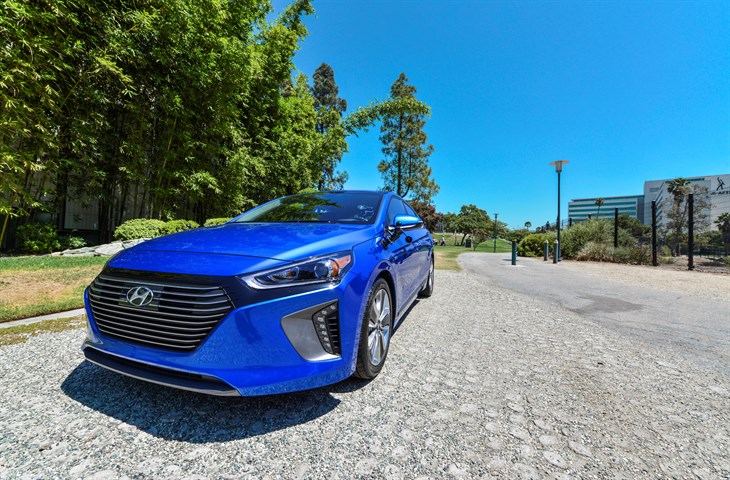Imagine Feeling What Your Autonomous Car Feels
In partnership with engineers from Hyundai, Jonathon Keats, an experimental philosopher and artist, has developed, Roadable Synapse, a concept that uses vehicle sensors to convey a sense of what the car is experiencing directly to the driver.
September 19, 2017

Talk to someone who loves their car and you'll often hear them talk about having a feeling of oneness with their vehicle and how their car feels like an extension of themselves. It's a sensation that may go away if autonomous cars become ubiquitous and transform cars from less of an individualized experience and more into a travel utility akin to trains, buses, and airplanes.
|
The Roadable Synapse project uses sensors technology applied to a Hyundai Ioniq to provide the driver with an audio experience that changed based on the vehicle's performance and external conditions. (Image source: Hyundai Motor / Museum Associates/LACMA) |
But what if it didn't have to be that way? What if sensor technology could allow even our autonomous vehicles to provide us with new levels of immersion and interaction with our vehicles – letting us experience what our cars are experiencing?
Hyundai, in partnership with the Los Angeles County Museum of Art (LACMA)'s Art + Technology Lab, have tapped San Francisco-based artist and experimental philosopher, Jonathon Keats to create Roadable Synapse, a conceptual art project designed to explore how drivers interact with their vehicles and how those interactions can grow and change as technology, particularly autonomous driving, advances in the automotive space. By outfitting a Hyundai Ioniq with new sensors, and by leveraging sensors already present in the vehicle, Keats and the R&D team at Hyundai were able to create a vehicle that uses audio to provide a novel sensory experience for the driver.
"We are constantly exploring how new forms of mobility can help us overcome current transportation limitations. Engaging with art and technology projects allows us to explore this field in entirely new ways," John Suh, Vice President at Hyundai Motor, said in a press statement.
The idea behind the concept is that it could provide a new level of connection with their vehicle for drivers and provide a more mentally and emotionally engaging experience when riding in autonomous vehicles. “I began the two-year development cycle by screening the neuroscientific literature, searching for ways in which to dynamically alter the driver’s psychological state based on incoming sensory data,” Keats wrote in an article for Nautilus. “I found that factors ranging from speed to aerodynamics could be viscerally experienced by modifying the sound environment in the passenger compartment. Further, the driver’s state of mind can be changed just by tweaking the music playing on the stereo (and it makes no difference whether the music is hip-hop or classical).”
The Roadable Synapse uses sensor data from various points on the car (including the engine) and converts those into unique audio responses for the driver. Music tempo changes based on the car's acceleration, the volume changes based on RPMs, and the audio will distort or become clearer based on driving efficiency. “By making music tempo faster as car goes faster, and stimulating the driver by that tempo, it becomes possible to make the driver psychologically shift in terms of time so the driver is feeling what the car is experiencing,” Keats explained in a documentary released by LACMA about the project (below).
Hyundai engineers even affixed anemometers, devices used to measure wind speed, to the outside of the car to measure the air flow over the left and right side of the car. By having the audio shift from left to right based on where the most airflow is, it creates a binaural hearing experience for the driver.
“I'm not an engineer so ultimately I'm not trying to develop a new technology,” Keats explained further. “I'm interested in the car as a vehicle to be able to explore a relationship with technology over the long term. Think about how we might relate to artificial intelligence, or at the opposite extreme what might happen as we become more one with our machines...and whether in fact that is advantageous.”
While Keats admits the Roadable Synapse is more of a thought experiment than anything else at this point, it does point to possible solutions to address some very real concerns about autonomous vehicles and how comfortable consumers will be with them. According to a 2016 survey conducted by AAA, while 59% of US drivers say they want autonomous functionality in their next vehicle, 78% said they are afraid to ride in a fully autonomous vehicle. Fifty-four percent of drivers surveyed also said they would be uncomfortable sharing the road with a self-driving vehicle.
Perhaps concepts like the Roadable Synapse, which gives riders a better sense of how the vehicle is responding to its environment, will help ease consumers' apprehension around them. Companies are already seeking to address this in other ways with AI systems, such as Microsoft's EmotionAPI and the Emotional AI SDK released by Affectiva, that could allow autonomous cars to better understand their passengers' emotional states and respond accordingly – reducing speed if the driver is feeling fearful, for example.
According to LACMA, Keats is also working on a next-generation of the Roadable Synapse that will take on more advanced sensory experiences, making the driver feel anxious when the engine needs servicing, and feel hunger when the car is low on fuel. Perhaps the real question is just how close do we really want to feel with our vehicles?
Watch a short documentary on Roadable Synapse released by LACMA:
|
Chris Wiltz is a senior editor at Design News covering emerging technologies, including VR/AR, AI, and robotics.
About the Author(s)
You May Also Like





